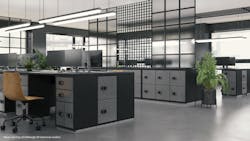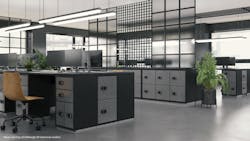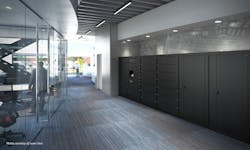This article originally appeared in the January 2022 issue of Security Business magazine. When sharing, don’t forget to mention Security Business magazine on LinkedIn and @SecBusinessMag on Twitter.
Over the past two years, the pandemic has changed nearly every aspect of our businesses, and we can anticipate that many things will not go back to how they were pre-COVID-19.
This is particularly true for building management, especially in commercial spaces. An August 2021 survey of more than 750 business executives by PwC found that about one-third of companies are planning to have a hybrid model of work, indicating the size and use of office spaces may decrease.
With the added layer of new health and safety concerns stemming from the pandemic, commercial spaces will need to be restructured to ensure the functional use of space, as well as the health and safety of workers.
As we emerge from the pandemic and return to offices and buildings, integrators need to help customers adapt quickly to the new normal as they upgrade their facilities to help keep everyone safe and secure in their everyday environments. Whatever steps can be taken now will make future transitions and upgrades easier and less costly.
Ultimately, integrators can play a critical role in helping facilities adjust to the new expectations and react quickly as other challenges emerge. There are three important trends that integrators should help their customers – facility, building, and security managers – consider when re-evaluating their spaces. As an integration partner, how can you help them address these new challenges with the right access control solutions?
New Ways of Working
As remote work and hybrid working models take hold, the old way of using space is gone. There is less need for dedicated individual office spaces, as employees may not be in the office every day; however, facilities will need to have more collaborative spaces for teams to gather safely, and temporary workspaces for those coming into the office two or three days a week.
For example, many companies are considering a hoteling seating model – where workers dynamically schedule use of in-office workspaces such as desks, cubicles and offices to limit the number of employees in the office at the same time and allow for more flexible hybrid working. This arrangement would also allow all workspaces and touchpoints to be cleaned each night to minimize germ transmission.
Further accommodation may be needed for this arrangement. For staff who would like to keep some personal belongings at work, lockers may be an option to keep things safe and secure on days when they are not in the office.
Managing People
The pandemic forced building requirements to change quickly in order to create safer spaces, something that end-users have come to expect from their workplaces. During the pandemic, many facilities took initial measures to keep people and the environment safe, such as using a temperature scanner at the entrance, placing social distancing decals on the floor, inserting plexiglass between desks and dispersing automatic hand-sanitation dispensers throughout the building.
As a next step for returning to the office, integrators can guide building managers to evaluate access controlLow-touch solutions and touchless solutions – such as wave-to-open switches and low energy door operators – can help mitigate the spread of germs and allow for seamless movement throughout a facility.
Reimagining how to use access control solutions will not only meet end-users’ expectations and needs but will also establish a safer, healthier environment and strengthen a building’s security.
More Efficient Building Management
In this digital-first era, a security manager’s role has become increasingly complex, and the challenges from the pandemic have only made it harder for them to do their jobs effectively and efficiently. They are often tasked with finding operational efficiencies, managing risk to the organization and those within, mitigating environmental impacts, leveraging the right technology solutions, guaranteeing compliance, and ensuring optimal safety and security of the facility. With this level of complexity, the role of the systems integrator is becoming that much more important.
As a trusted partner, integrators can help customers choose the right access control solutions and enable them to manage and monitor many of these tasks remotely.
Integrators should highlight the many access control solutions available that would allow facility managers to provide access to and/or lock rooms remotely or grant access to certain people on a specific date and time. And with mobile credentials, facility managers can issue keys remotely, eliminating the need to go to an office environment to have keys programmed, reducing the potential for germ transmission and enabling better control and auditability of who is accessing various locations.
Additionally, entrance and egress access points can all be monitored and tracked remotely and alert managers of any problems. For example, if an exit door is held open for a long period of time, the system would alert the managers of that location to see if there is a problem or something in the way of the door closing properly. As businesses manage remote and hybrid workforces, the ability to issue access rights and manage challenges over the air is paramount.
Angelo Faenza is Head of Digital Access Solutions for ASSA ABLOY Opening Solutions Americas. Learn more at www.intelligentopenings.com or request more information at www.securityinfowatch.com/10212899.
About the Author

Angelo Faenza
Angelo Faenza is head of U.S. Digital Access Solutions for ASSA ABLOY Opening Solutions Americas. www.assaabloydss.com



